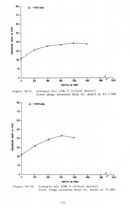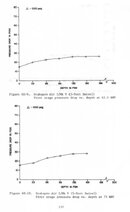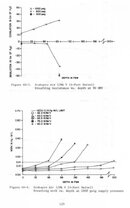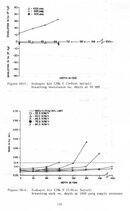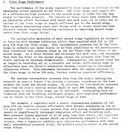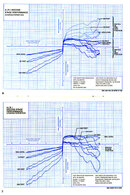so at what point do you deem those values relevant and how does that argument apply to the second stage swivel?
Those values are relevant as they show how a 90 degree turn can influence air flow. But, they 90 degree turn is into a chamber, rather than more restricted in a hose. I would expect the change to be greater in a hose (the 90-degree elbow) than in the chamber because of the restrictions. It's like having a mass of people go down a hallway at full tilt, running, and then having to turn 90 degrees into another hallway. There will be more congestion than if that mass of people were released into a room and have to find an opening at 90 degrees to the entrance hallway. In order for this analogy to actually depict what happens, the hallways and room would need to already be packed with people, and at the end an opening allows the people to start running, creating a space for other people to run, until the whole thing starts to move. In the hallway with the 90 degree turn, when the packed people run up against the wall, some will turn left and some right, and those turning against the opening will have a harder time getting back through (the hallway rather than the room).
I don't think anything over 40lpm/1.4cfm is really relevant, and anything deeper than 132 really isn't relevant since those are outside of the scope of recreational diving.
Well, I'm not so sure of that. Yes, they are probably outside the "normal" sport diving criterion, but, and this is a big "BUT," when you need it, you really need it. We have reports of divers caught in down-currents. We have divers who must lift a heavy object to the surface, or rescue a diver (part of sport diving).
The pressure drop graphs at that range you chose not to upload, and that has a roughly 25psi ip drop for the 5 port, and 30psi drop for the 4 port. Hardly significant in the scope of work of breathing as shown by the WoB being between .1 and .14 for that test cycle. Much of that can largely be given to the cycle time of the regulator which if you breathed at that rate for any length of time *more than about 30 seconds* would cause you to pass out.
Here are a couple of my air consumption rate calculations:
Date: 6-19-2011
Surface Air Consumption Rate:
Used twin 42 cubic foot tanks (PJ tanks), for a total of 84 ft3@2100 psig. Started at 1700 psig. 1700psi /2100psi = 0.81 x 84 ft3 = 68 ft3 available. 700psi /2100psi = 0.33 x 84 ft3 = 28 cubic feet still in the tanks at the end of the dive. 68 ft3 – 28 ft3 = 40 cubic feet used in 22 minutes. 40 ft3 / 22 minutes = 1.8 cubic feet per minute used.
Date: 6-11-2011
Surface Air Consumption Rate (SACR):
Used twin 45 cubic foot tanks, for a total of 90 ft3@1800 psig. Started at 1400 psig. 1400psi /1800psi = 0.78 x 90 ft3 = 70 ft3 available. 300psi /1400psi = 0.21 x 70 ft3 = 15 cubic feet still in the tanks at the end of the dive. 70 ft3 – 15 ft3 = 55 cubic feet used in 52 minutes. 55 ft3 / 52 minutes = 1.06 cubic feet per minute used.
Both of those dives were in the Clackamas River at about 25 feet max depth. But I have had more rigorous dives, where I tested fins and swimming techniques, and spent most of the dive swimming against the current, emptying a single 72 in less than a half an hour. I didn't pass out either. Here's a YouTube video I produced of two of my dives last spring:
You will notice that my breathing rate is about 20 breaths per minute, and I have a six liter vital capacity. I imagine I'm breathing between 4 and 5 liters per breath. So that's between 80 and 100 liters per minute, or 2.8 to 3.5 cfm. You only pass out if the regulator is not giving you enough air! A surface air consumption rate is just that, a rate over time. There is also an instantaneous rate, which can be several times higher than the averaged surface air consumption rate.
So again, how does that chart apply to recreational diving? You posted values for 62.5 and 75 rmv's, can you maintain a SAC rate of 2.5cfm for any duration of time? I highly doubt it.
Yes, and have when I test underwater swimming techniques against a 2 know current. I have done that, at age 71, for over 20 minutes.
Do you regularly violate the accepted max depths of recreational diving at 132 where the gas density starts to cause significant variance between the two? I certainly hope not.
No, not in recent decades.
Since 40 lpm or 1.4cfm is really an elevated SAC rate, do you feel that the difference between a WoB of 0.08 and 0.10 is significant? If so, why?
Yes, because you can get into those situations without being deep. This work of breathing is expressed in kilograms x meters per liter of air breathed. If you'll look at the NEDU document below, on pages 4-6 and 4-7 you'll see that regulators which "exceeded limits" were involved in shallow water fatalities.
http://archive.rubicon-foundation.o...0662/NEDU_TM_15-01_7_July_2015.pdf?sequence=1
How do you know that the second stage elbows yield a similar net effect that is measurable and meaningful within the scope of recreational diving?
Well, it's intuitive that any 90 degree turn, especially in a restricted space, will produce turbulence. As stated above, the turbulence inside the 90-degree elbow is probably greater than inside the first stage of Scubapro's piston stage. But we would actually need to measure this to get an accurate reading on what it does to the interstage pressure under high demand. You don't need to be at extreme depth to have very high exertion rates. All that needs to happen is some emergency, or some unforeseen event (catching a boat in rough water comes to mind) to require a lot from a regulator.
SeaRat
PS, I had to take off the attribution quotes to make this post work. My apologies. I was quoting "tbone 1004."



